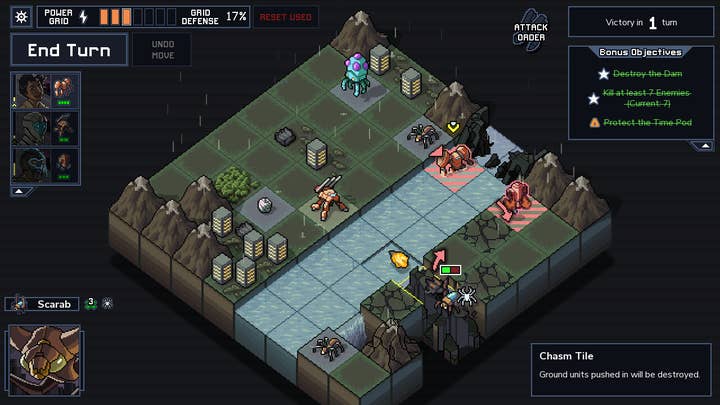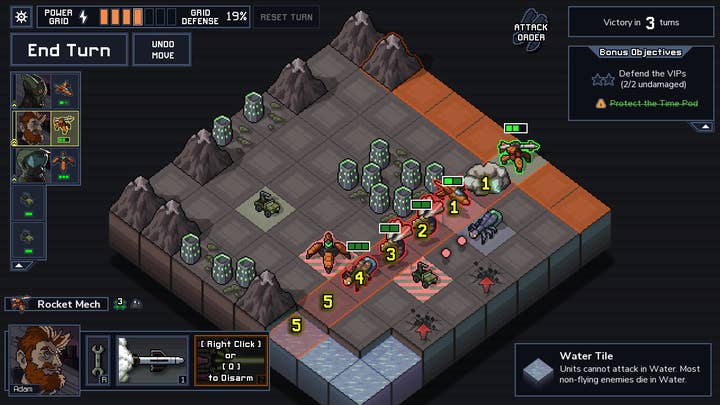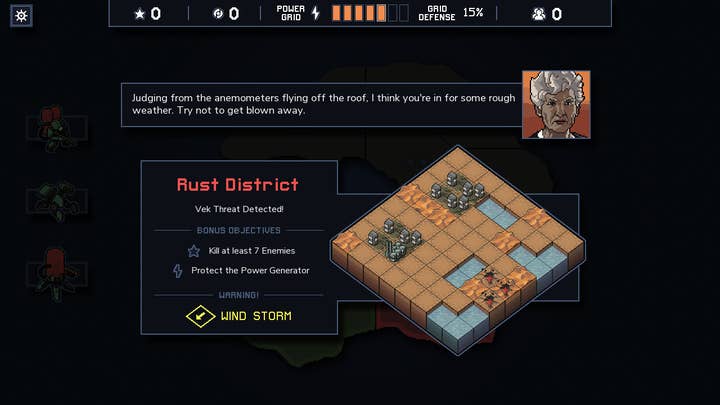Once more Into the Breach | Why I Love
Foretales creative director Alain Puget lavishes praise on Subset Games' sublimely designed turn-based strategy game
Why I Love is a series of guest editorials on GamesIndustry.biz intended to showcase the ways in which game developers appreciate each other's work. This entry was contributed by Alain Puget, creative director of Alkemi, which recently launched the card game narrative journey Foretales on PC and Switch.
When I launched Into the Breach for the first time, I was not prepared for what hit me.
You see, when I tried FTL, the real-time strategy roguelike debut title from Subset Games, I very quickly bounced off of it, hard. It felt very random and unfair to me, and it took a whole afternoon of discussion with friends, who were very hardcore fans of FTL, to convince me to try it again. The second time around with a few basic tips from them, I finally got why the game was indeed an absolute gem.
With Subset's follow-up, Into the Breach, however, things clicked in my brain immediately. Thirty minutes in, I knew the game would be one of my all-time favorites.
But first, a little background into what the game is and how it works. Into the Breach is a turn-based tactical game where you chain fights with a squad of exactly three giant robots against a horde of gigantic insects intent on destroying the local human population. Each mission takes place on an 8x8 grid and lasts exactly five turns. With those constraints, one might think that such confrontations could become repetitive fast, but a lot of variety is introduced by the nature of the insects, the environments and your objectives.

Your main goal is always to protect civilian buildings, but important bonus points will be granted to accomplish secondary objectives like: killing more of a certain number of enemies, killing less than a certain number of enemies, protecting a moving train across the map, protecting civilian vehicles, etc. These secondary objectives and their rewards are so important for your progression that you need to alter your strategies to achieve as many of them as possible.
In between the 15-minute fights, each and every one of your choices is super simple but impactful in terms of gameplay: What's your next destination on the map? Which upgrades will you buy for your mechs? The road to victory is fraught with difficult decisions.
Each and every one of your choices is super simple but impactful in terms of gameplay
Every progression choice is guaranteed to be impactful because all game systems are super simple and lean. The board is only 8x8, enemies and mechs alike have 1 to 8 hit points max, they deal damage of 1 to 5 hit points, and move between 3 to 6 squares each turn. Those values are so low and condensed that even a modifier of +1 or -1 dramatically tips the scales in one army's favor.
The care and weight given to each parameter is amazing and the overall balance always feels perfect. The movement system, the execution order of attacks, and environmental effects are so simple and elegant that it's easy to understand every variable necessary to identify threats, avoid casualties, and reduce the enemy forces.
Another very important part of the game is how you can incapacitate or move hostiles with your robots. An attacking enemy pushed one square over could become a temporary ally, as they'll inadvertently target another insect instead of a civilian building. It always feels amazing to outsmart the enemy into destroying their own forces!

Each turn of a fight becomes one of those chess puzzles where you're given a starting situation and need to find the best moves for the best possible outcome. Good players will solve the situation at hand while averting most civilian casualties this turn; great players will solve the current crisis and try to position themselves to get an edge on the next turn. They will also know when it's worth taking damage on their mechs, or even on civilians, if some other secondary objectives seem more important in the long run.
There is absolutely no grinding or filler in this game. Progression is steady and every bit of it feels important
There is no other game I know of that condenses that amount of critical decision making in so little time. Each one of your moves is important and the battlefield is so packed that even the order of their execution is often critical. There is absolutely no grinding or filler in this game. Progression is steady and every bit of it feels important.
Don't keep secrets from your players. This is maybe the biggest lesson I've learned as a game designer from playing Into the Breach. At the beginning of each turn the game shows you literally everything that will happen: where enemies will attack, in what order, and where enemies will spawn on the next turn. The only unknown is the movement of enemies between each turn, but even that you can have a pretty good educated guess about once you've played enough of the game.
Each time you select an attack, you'll have a preview of its direct effects and all of its consequences: This shell will inflict 1 damage to this bug, pushing it into this other bug, dealing one additional damage to both bugs, killing the second insect and setting fire to the forest under the first… fire that will in turn inflict 1 damage to your initial target. That's a complicated chain of events! Yet you read all of this with a super clear user interface overlayed on the map when you roll over a target. It seems simple and easy to take for granted, but the amount of UI design and care behind this is mind boggling!
Showing enemy intents to avoid guess work would not have been my first instinct when designing such a game. On the surface that sounds like it would alleviate much of the challenge. But it leads to such a clarity of the situation that all the decision making becomes much more evolved and satisfying. You can be faced with overwhelming forces and feel super smart because you've found one of the few ways to counter any and all attacks and set yourself up in a good position for your next turn.
I can safely say that all of my games from this point were and will be impacted by this realization. Time spent deciphering complex situations is not time well spent, and if you give players all the information, it means that you can put them in even trickier situations that make them feel smarter for finding clever ways out of them.

Into the Breach treats narration in the same straight-to-the-point fashion. No lore dumps, no long dialogues at any point. Mission and campaign briefings are super short with just a hint of local flavor for each of the four islands where you fight. Most of the lore comes from the barks of your units, civilian buildings and mission givers during the course of the game. Mechs-vs.-alien-insects is a very classic sci-fi setup, but it's efficient and never gets in the way.
It's really funny to talk with a friend and realize that their favorite squads are absolutely not the same as yours since your brains do not work the same way
The last impressive feat of the game is how it handles the replayability and customization of your experience. Sure, there's a fairly classic difficulty system with easy, normal and hard levels, but the difficulty of Into the Breach doesn't just come from the numbers or power of your opponents. It's also largely due to the capacities of your brain to fully understand how your robots can be used on the battlefield in the most efficient way.
The default team is fairly easy to master, with very straightforward damaging and "pushing" attacks. But among the 14 robot squads that you'll have to master to fully complete the game, some of them will require complete rewiring of your brain based on what you've learned. It's really funny to talk with a friend and realize that their favorite squads are absolutely not the same as yours since your brains do not work the same way.
Difficulty is one parameter but length is another. A game of Into the Breach is composed of a minimum of two mini campaigns to free two islands from the invasion. At this point, you are free to try the final mission, a two-part siege where aliens will throw anything they have at you! But you can also choose to continue and try to free a third or even a fourth island. This adds a risk/reward mechanic, as doing two additional campaigns increases your chances of a game over, should you fail at liberating an island, and the final mission will feature more powerful enemies the longer you wait, but these longer campaigns offer more time to improve your mechs, buy additional weapons, and upgrades and level up your pilots. If everything goes according to plan, you could be able to completely steamroll the final assault with a super optimized squad. The game is so well balanced that this feature becomes less a difficulty choice rather than just a game experience customization. Yet another impressive feat!
I could honestly go on like that for pages (Did I mention how the enemy AIs seem to adapt the severity of their attack based on how much they outnumber your forces?), marveling at each and every little detail and design choice that makes this game an absolute masterclass in game design. Even if you're not really into strategy, do yourself a favor and give it a try! In fact, you might have access to a copy of Into the Breach without knowing it! Since July 2022, the mobile version is part of the Netflix games you can download if you're a subscriber of the streaming service. Warning: you may find yourself endlessly addicted.
Developers interested in contributing their own Why I Love column are encouraged to reach out to us at news@gamesindustry.biz.
